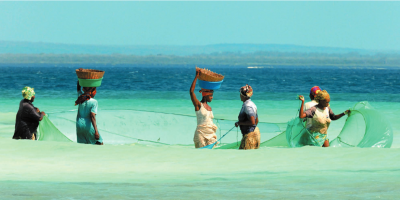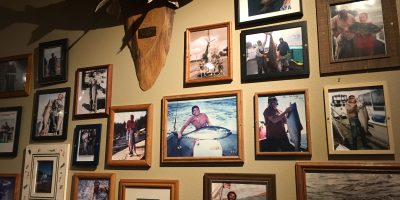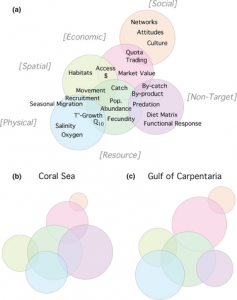Post by: Benjamin Cook & Robb Poier, UW Biology undergraduate students, and Frieda Luoma-Cohan, UW Environmental Studies undergraduate
In the first 2018 Bevan Series lecture Dr. Ray Hilborn described annual fisheries stock assessments as “where men in dark robes in dark rooms gather.” Thankfully it’s not that bad. Still, a lot of different people want a lot of different things from our oceans. While environmentalists (and the fish) might want to see thriving fish populations, the economist favors quotas promoting profits and employment, and the average citizen just wants to go fishing with their kids or grandkids. While any one fishery means different things to different stakeholders (i.e., groups with a vested interest in a stock of fish) they are all bound to the same stock assessment that dictates quotas. Balancing ecological, economic, and societal goals in one assessment isn’t easy, but with new statistical models it may be getting easier.
Goldilocks, best known for her criminal history and aversion to bears, has a philosophy that may be considered analogous to stock assessments. If Goldilocks was a fisheries scientist, she would have a familiar problem on her hands. On one end of the table is the single-species assessment: somewhat simplistic and tailor-made for each species, used for ‘tactical’ decisions regarding yearly quotas in hopes of reaching maximum sustainable yield. But this single-species assessment does not account for interactions with other fish or the environment. On the far end of the table are whole ecosystem models, which can have hundreds of interactions between species and provide a “big picture” of the ocean ecosystem, but lack detail for a specific fish stock.
The “just right” for Goldilocks (and us) are ‘Models of Intermediate Complexity for Ecosystem assessments’ (MICE). Complex enough to include interactions, but focused enough to make tactical decisions. Ideally, MICE models can be used for long term or short term management decisions. One of the greatest things about MICE models is that they can use data to balance social, economic and environmental concerns all at once. This is known as the “Triple Bottom Line,” a term used in a 2013 paper by this week’s Bevan Series speaker and creator of the MICE model Dr. Éva Plagányi-Lloyd.
Dr Plagányi-Lloyd knows all about getting things just right. She has spent the last 15 years working with fisheries stock assessments, developing management models that not only preserve the ecological integrity of the oceans, but also consider equity when it comes to delicate social complexes. An excellent example of this is her work on the beautifully patterned Torres Strait Tropical Rock Lobster, which may not have claws like its Atlantic Ocean cousin, but is a major fishery in Australia. It’s the second largest fishery in the Torres Strait and has been fished for hundreds of years!
The lobster is fished traditionally by hand or with short spears by divers. Commercially, they are caught in pots. All of the stakeholders in this fishery support the continued sustainability of these crustaceans either for profit or cultural reasons, which poses an interesting problem for resource management. Indigenous people have a right to fish in Torres Strait, just as much or even more so than commercial fisherman.
How to manage what matters, when what matters is different for each stakeholder? Dr. Plagányi-Lloyd saw a perfect opportunity to use the MICE model, and created an excellent case study for including the Triple Bottom Line in fisheries management, where socio-cultural, economic and ecological sustainability were all addressed. Using this modeling approach has led to policy changes that keep all stakeholders, including the lobster (which are not being overfished) happy.
With researchers like Dr. Plagányi-Lloyd we are able to better prepare for problems in the future and provide guidance in the management of fisheries from start to finish. As computational power increases, mathematical models like these can project answers with increasing accuracy. By simplifying complex models to an intermediate level, we may find more clarity about fisheries management, where everything is “just right”.
We caught up with Dr.Plagányi-Lloyd after her seminar, and got to ask her a few questions:
UW Students (UWS): How did you first get in contact with UW?
Dr Eva Plaganyi-Lloyd (EPL): It was actually through Andre [Punt] on some modeling work; [Dr. Punt is the director of the School of Aquatic and Fishery Sciences at UW, and a professor in decision analysis and numerical computing in natural resources]
UWS: What was your hardest project?
EPL: It was probably working on the crown of thorns starfish; Dr. Plaganyi-Lloyd has worked on models determining the most effective treatment of the invasive, coral eating starfish. One of their natural predators, the giant triton snail (Charonia tritonis) was devastated by overfishing, but researchers hope this massive mollusc can curb the destruction caused by the spiny, predatory starfish.
UWS: How long did developing MICE take?
EPL: Oh – a few years, but now it can be adapted to a new species in a few weeks [great for implementing with new fish stocks or other research questions!]
Finally, Dr. Plagányi-Lloyd stressed to us the importance of connecting with the people involved around your research. It seems like a simple thing, but can have a huge impact.
References
Lim-Camacho, L., Plagányi, É E., Crimp, S., Hodgkinson, J. H., Hobday, A. J., Howden, S. M., & Loechel, B. (2017). Complex resource supply chains display higher resilience to simulated climate shocks. Global Environmental Change, 46, 126-138. doi:10.1016/j.gloenvcha.2017.08.011
Plagányi, É. E., Punt, A. E., Hillary, R., Morello, E. B., Thébaud, O., Hutton, T., Pillans, R. D., Thorson, J. T., Fulton, E. A., Smith, A. D. M., Smith, F., Bayliss, P., Haywood, M., Lyne, V. and Rothlisberg, P. C. (2014), Multispecies fisheries management and conservation: tactical applications using models of intermediate complexity. Fish Fish, 15: 1–22. doi:10.1111/j.1467-2979.2012.00488.x
Plagányi, É. E., Putten, I. V., Hutton, T., Deng, R. A., Dennis, D., Pascoe, S., . . . Campbell, R. A. (2013). Integrating indigenous livelihood and lifestyle objectives in managing a natural resource. Proceedings of the National Academy of Sciences, 110(9), 3639-3644. doi:10.1073/pnas.1217822110
Staff profile. (n.d.). Retrieved January 24, 2018, from http://people.csiro.au/P/E/Eva-Plaganyi-Lloyd








Edward
the fact that now fish are exposed to climate change and because of their sensitive nature to changes in the environment, it is making many fish species vulnerable and soon many will be extinct, more has to be done to stop this before its too late..